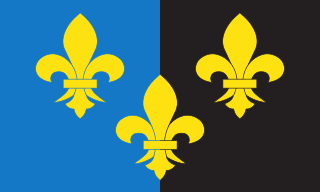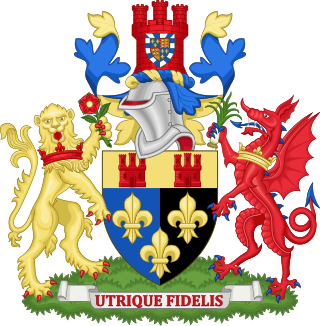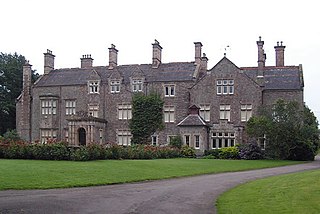History
The building was commissioned to accommodate the quarter sessions for Monmouthshire which had previously been held on the first floor of the Old Town Hall in Old Market Street. [3] The court was designed by Thomas Henry Wyatt in the Italianate style, built in mauve sandstone with dressings of Bath stone, [1] and was officially opened by the chairman of the quarter sessions, Samuel Bosanquet, in 1877. [4]
The design involved a symmetrical main frontage of five bays facing onto Maryport Street, with the end bays projected forward. The central section of three bays featured a loggia, formed by three round-headed arches with architraves and keystones, flanked by sash windows with triangular pediments, while the outer bays were fenestrated large round-headed windows. The bays were separated by Tuscan order pilasters and surmounted by a cornice and parapet [5] which was broken by a balustrade above the loggia. Internally the principal rooms were the two courtrooms. [2] A passage was built under the dock leading through to Usk Prison which stands next door. [6]
The case of Josef Garcia, a Spanish seaman, was reputedly heard there; [6] he was eventually tried and convicted of the murder of William and Elizabeth Watkins of Llangybi and of their three youngest children Charlotte, Alice and Frederick at the Gloucestershire Assizes in 1878. [7] The Sessions House was also the location for the trial of Margaret Mackworth, 2nd Viscountess Rhondda, [6] a prominent suffragette, in 1913. [8]
Court Number 1 was badly damaged in a fire in 1944 but Court Number 2 survived with little changed. [1] Usk Town Council reports that "There is an impressive judge's chair and the benches retain their original labels for Counsel, Solicitors, Reporters, Jury etc." [6] The quarter sessions moved to Newport in 1950 and Court Number 1 was demolished in 1970. [2]
The building continued to serve as a magistrates' court until June 1995 and then remained empty and deteriorating until it was purchased by Usk Town Council to mark the millennium in 1999. [9] Following an extensive programme of refurbishment works costing £200,000, the building was re-opened by the High Sheriff of Gwent, Lady Hayman-Joyce, in May 2011. [10] [11] It is now used for meetings of the town council and for community use. [6]

Usk is a town and community in Monmouthshire, Wales, 10 miles (16 km) northeast of Newport. It is located on the River Usk, which is spanned by an arched stone bridge at the western entrance to the town. Usk Castle, above the town, overlooks the ancient crossing point. It developed as a small market town, with some industry including the making of Japanware, and with a notable prison built in 1841–42. In recent years, Usk has become known for its history of success in Britain in Bloom competitions, winning the "Wales in Bloom" competition 35 times in a row between 1982 and 2016. The resident population of the town in 2011 was 2,834, decreasing to roughly 2,600 in 2021. 6.8% of the population are recorded as being able to speak Welsh.

Newport is a city and county borough in Wales, situated on the River Usk close to its confluence with the Severn Estuary, 12 mi (19 km) northeast of Cardiff. The population grew considerably between the 2011 and the 2021 census, rising from 145,700 to 159,587, the largest growth of any unitary authority in Wales. Newport is the third-largest principal authority with city status in Wales, and sixth most populous overall. Newport became a unitary authority in 1996 and forms part of the Cardiff-Newport metropolitan area, and the Cardiff Capital Region.

Monmouthshire is a county in the south east of Wales. It borders Powys to the north; the English counties of Herefordshire and Gloucestershire to the north and east; the Severn Estuary to the south, and Torfaen, Newport and Blaenau Gwent to the west. The largest town is Abergavenny, and the administrative centre is Usk.

Until 1974, Monmouthshire, also formerly known as the County of Monmouth, was an administrative county in the south-east of Wales, on the border with England, and later classed as one of the thirteen historic counties of Wales. Its area now corresponds approximately to the present principal areas of Monmouthshire, Blaenau Gwent, Newport and Torfaen, and those parts of Caerphilly and Cardiff east of the Rhymney River.

HM Prison Usk is a Category C men's prison, located in Maryport Street in Usk, Monmouthshire, Wales. The prison is operated by His Majesty's Prison Service, and jointly managed with the nearby HMP Prescoed.

Llanvair Discoed is a small village in Monmouthshire, south-east Wales, 6 miles west of Chepstow and 10 miles east of Newport.

Newport Civic Centre is a municipal building in Godfrey Road in Newport, South Wales. The civic centre, which is the headquarters of Newport City Council, is a Grade II* Listed building.

Newport Castle is a ruined castle in Newport, Wales. It was built in the 14th century, probably by Hugh de Audley, 1st Earl of Gloucester or his son-in-law, Ralph, Earl of Stafford, with the purpose of managing the crossing of the River Usk. The castle was used as administrative offices for the collection of rent and dues from local tenants, and was also a residence and a garrison. In 1402 it was sacked by Owain Glyndŵr. It was in disrepair by 1522, and was taken by Oliver Cromwell's forces during the Civil War. Its use declined further in later centuries. It has been a Grade II* Listed building since 1951.

Monmouthshire County Council is the governing body for the Monmouthshire principal area – one of the unitary authorities of Wales.

Tredunnock is a small village in Monmouthshire, south east Wales, in the United Kingdom. Tredunnock is located four miles (6.4 km) northeast of Caerleon and four miles south of Usk.

Llantrisant is a village in Monmouthshire, south east Wales, United Kingdom. The community population at the 2011 census was 475.

The Mansion House is a property in Stow Park Circle in Newport, Wales. It was the official residence of the Mayor of Newport, South Wales until 2009 and has since become the local register office.

The Shire Hall, Monmouth, Wales, is a prominent building on Agincourt Square in the town centre. It was built in 1724, and was formerly the centre for the Assize Courts and Quarter Sessions for Monmouthshire. The building was also used as a market place. In 1839–40, the court was the location of the trial of the Chartist leader John Frost and others for high treason for their part in the Newport Rising.

Margaret Haig Mackworth, 2nd Viscountess Rhondda was a Welsh peeress, businesswoman and active suffragette who was significant in the history of women's suffrage in the United Kingdom.

Cefntilla Court,, Llandenny, Monmouthshire, Wales, is a country house dating from the mid-19th century. Its origins date from 1616. During the English Civil War, the court was the headquarters of Thomas Fairfax during the siege of Raglan Castle and the terms of the castle's surrender were signed at the house in 1646. By the early 19th century, the court was derelict. In 1856 it was sold by Crawshay Bailey to the Memorial Committee established to commemorate the life of FitzRoy Somerset, 1st Baron Raglan, British commander during the Crimean War. The house was completely rebuilt by Thomas Henry Wyatt and donated to Lord Raglan's heir, Richard Somerset as a memorial to his father. The house is a Grade II* listed building.
Thomas Prothero (1780–1853) was a Welsh lawyer, mine owner and businessman, known as an opponent of John Frost.

Monmouthshire is a county and principal area of Wales. It borders Torfaen and Newport to the west; Herefordshire and Gloucestershire to the east; and Powys to the north. The largest town is Abergavenny, with the other major towns being Chepstow, Monmouth, and Usk. The county is 850 km2 in extent, with a population of 95,200 as of 2020. The present county was formed under the Local Government (Wales) Act 1994, which came into effect in 1996, and comprises some sixty percent of the historic county. Between 1974 and 1996, the county was known by the ancient title of Gwent, recalling the medieval Welsh kingdom. In his essay on local government in the fifth and final volume of the Gwent County History, Robert McCloy suggests that the governance of "no county in the United Kingdom in the twentieth century was so transformed as that of Monmouthshire".

Ynys Hafod, Henllys and Min Yr Afon, New Market Street, Usk, Monmouthshire, are three houses forming a continuous range in the centre of the town. Each house is a Grade II* listed building.

County Hall, Cwmbran was a municipal facility on Turnpike Road in Croesyceiliog in Cwmbran in Wales. It was the headquarters of Gwent County Council from 1978 to 1996 and of Monmouthshire County Council from 1996 to 2013.

The Old Town Hall is a municipal building in Old Market Street, Usk, Monmouthshire, Wales. The structure, used as the local club of the Royal British Legion, is a Grade II listed building.




















